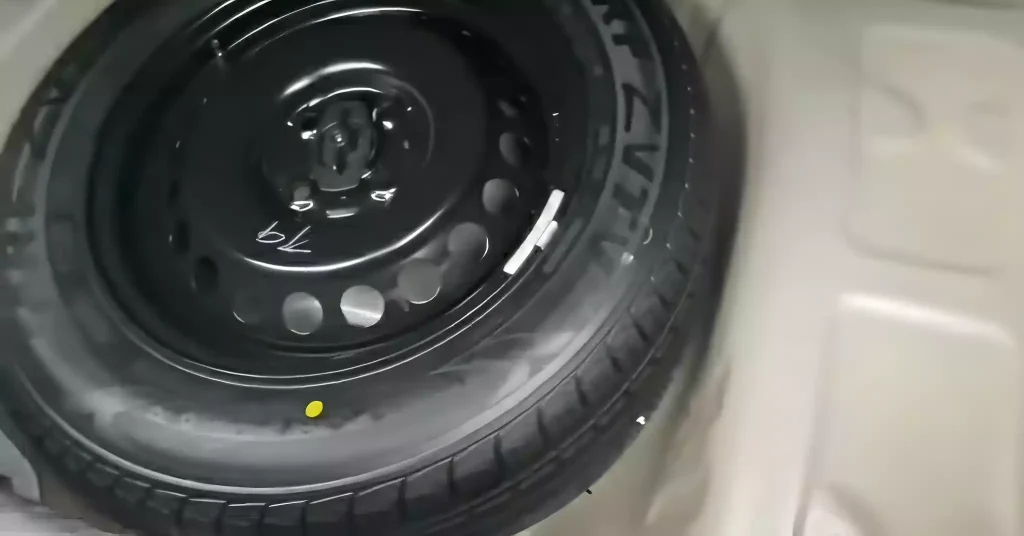Have you ever wondered how far you can actually drive on that little spare tire in your trunk? Maybe you got a flat on the freeway and limped to the nearest exit, hoping there was a tire shop nearby. Or perhaps you’ve been driving for what seems like forever on your temporary tire and are starting to get worried.
We’ve all been there – your regular tire pops and you have to put on the spare to get you to a repair shop. But how long can you actually drive on a spare tire? The answer isn’t straightforward and depends on several factors. Keep reading to find out the definitive answer to how long you can cruise on your compact companion.
What Is a Spare Tire For?
A spare tire is meant to be a temporary solution to get you to a repair shop or dealer to have your regular tire fixed or replaced. It’s not designed for long drives or extended use.
How Far Can You Go?
As a general rule of thumb, you should only drive on your spare tire for 50 to 200 miles max before getting your regular tire repaired or replaced. The exact recommendation will depend on your vehicle’s make and model, so check your owner’s manual for the specifics.
Driving too far on a spare can be dangerous for a few reasons:
- Spare tires are often smaller in size and have less tread than your regular tires, so handling, braking, and traction are reduced.
- The spare was not installed or balanced when your regular tires were, so it can affect the steering and ride quality.
- Spare tires are not meant for high-speed driving. Most recommend keeping it under 50-60 mph.
- The spare tire is not designed to withstand the forces of long drives, especially fully loaded or towing a trailer. It could overheat or fail.
In short, a spare tire should only be used to get you to a repair shop as soon as possible. Every mile driven on the spare reduces its lifespan, and you never know when you might need it in an emergency. It’s just not worth the risk to your safety or your spare tire to push its limits. Get your regular tire fixed and get back on the road safely!
How Long Can You Drive on a Spare Tire?

So your tire blew out and now you’re stuck with a tiny spare. The big question is, how long can you actually drive on it? The short answer is: not long. But don’t panic, you should have enough time to get somewhere safe.
A spare tire is meant to be a temporary solution to get you to a repair shop or dealer as soon as possible. As a rule of thumb, you should drive less than 50-60 miles per hour and less than 50-100 miles total before replacing it. Driving too far or too fast on a spare can damage it or your vehicle.
There are a few reasons spares can’t go the distance:
- They’re smaller and have less tread, so they don’t grip the road as well. This impacts braking, handling, and safety.
- They’re typically not meant for driving over 50 mph since they can overheat or come apart at high speeds.
- The wheel and tire size difference will impact how your vehicle steers and handles. It can strain the axle and transmission.
- Spares often don’t have a matching tread pattern or load rating as your normal tires. This also impacts performance and safety.
The bottom line is to take it slow, avoid sudden braking/acceleration, or turn sharply. Get to a shop within the recommended range to have your normal tire repaired or replaced. Your spare has done its job – now it’s time to get back to fully functioning tires and a safe ride. Use your spare wisely and you’ll make it through, just don’t push your luck!
Factors That Determine How Long Your Spare Tire Will Last
The lifespan of your spare tire depends on several factors. How long it will last before needing replacement depends on things like:
- Tire age and condition. If your spare tire is older than 6 years, it’s probably time for a replacement. As tires age, the rubber compounds break down and the tread wears thinner, even with little use. An old, worn-down spare won’t perform as well as a newer tire and may not last long if put into service.
- How often it’s used? Repeatedly using your spare tire, especially for long distances or at high speeds, will accelerate the wear and reduce its lifespan significantly. Only use your spare for emergencies and have your regular tire repaired or replaced as soon as possible.
- Proper inflation. An under-inflated spare tire won’t last as long and won’t handle properly if you need to use it. Check your spare tire pressure regularly and inflate it to the recommended PSI listed in your owner’s manual or on the tire placard located in the driver’s side door jamb or fuel door.
- Storage conditions. How you store your spare tire also impacts its longevity. Storing it under extreme heat or cold temperatures, or in direct sunlight for long periods can cause the rubber to deteriorate faster. The trunk or under the vehicle are best – avoid prolonged outdoor storage.
- Tire size and rating. A smaller spare tire, like a temporary “donut” spare, or one with a lower speed rating won’t last as long as a full-size matching spare. Use it only for emergencies and replace it with a full-size spare as soon as you can.
- Driving conditions. Aggressive driving on rough, unpaved roads or in severe weather will reduce a spare tire’s lifespan. Take it easy on your spare and avoid harsh road conditions when possible.
As you can see, there are many factors involved in determining how long you can safely drive on your spare tire. To get the maximum life from your spare, follow the tips above and remember – it’s meant to be used only temporarily in an emergency. Get your regular tire repaired or replaced right away.
Spare Tire Size Matters

The size of your spare tire matters for how long and how far you can drive. If your spare is a full-size tire, you’re in luck—you can drive on it just like a regular tire until you get your flat one repaired or replaced. However, if you have a temporary compact spare, you’ll need to be more careful.
Compact spares, often called “donut” spares because of their shape, are smaller in size and have less tread. They are not meant for long distances or high speeds. As a rule of thumb, you should not drive over 50-60 miles per hour with a compact spare, and you should get your regular tire fixed or replaced within 50-200 miles. Driving too fast or too far can damage the compact spare and reduce its effectiveness in an emergency.
Some compact spares also have a weight limit, like 60-80% of your vehicle’s maximum axle weight. Make sure you don’t overload the spare tire by carrying heavy equipment or cargo. Exceeding the weight limit could cause the spare to fail or affect your vehicle’s handling and braking.
It’s always best to check your owner’s manual for the specifics of your compact spare—its size, speed, and distance limits. If used properly within those limits, a compact spare should get you where you need to go in an emergency until you can get a replacement tire put on. However, for the safest driving and to avoid damaging your spare, have your regular tire repaired or replaced as soon as possible.
Driving on any spare tire can be risky, so take it slow, avoid sudden braking or turning, and get back on four regular tires again quickly. Your spare is meant to be temporary—the sooner you can get a replacement tire installed, the safer you’ll be and the less likely you’ll damage your spare.
Driving Conditions Impact Spare Tire Longevity

Driving on a spare tire is meant to be temporary, but how long is too long? The conditions you drive in can impact how long a spare tire will last before needing replacement.
Road Conditions
The type of roads you drive on makes a big difference. Smooth, well-maintained roads will maximize the life of your spare. Rough, unpaved, gravel, or dirt roads can damage the spare and reduce how long it lasts. The impacts and vibrations from uneven road surfaces accelerate wear and tear. Stick to major highways and paved roads as much as possible until you can get your regular tire repaired or replaced.
Speed Limit
Driving at lower speeds is easier on your spare. Most spares have a maximum speed rating of 50 to 60 mph. While a spare tire can physically go faster, higher speeds generate more heat which can damage the tire. Limit your driving to 45 to 55 mph to avoid overheating the spare. Slower is safer, as spares typically don’t handle as well as your regular tires at high speeds.
Distance Limit
As a general rule of thumb, you should limit driving on a spare tire to 50 to 200 miles maximum before replacement. Some spares may specify a shorter recommended range, so check your owner’s manual. The less you drive, the better. Only use the spare to get to a repair shop or dealer, and have your regular tire fixed or replaced promptly.
Weight Considerations
The load in and on your vehicle also impacts your spare. Heavier loads mean more stress and strain on the tire. Remove unnecessary items from your trunk or roof rack when driving on the spare. Also, avoid towing trailers or hauling heavy payloads which can overload the spare. For the best results, keep your vehicle as lightly loaded as possible until your regular tire is ready to go back on.
By following these tips regarding road conditions, speed, distance, and weight, you can maximize the temporary use of your spare tire. But remember, a spare is not meant for long-term driving, so get your regular tire repaired or replaced right away. The spare is really only meant to get you out of an emergency situation, not to continue normal driving.
Speed Limits for Driving on a Spare

When driving on a spare tire, it’s critical to follow the recommended speed limits to avoid damage or unsafe handling. The spare tire is not meant for high-speed or long-distance driving.
Do Not Exceed 50 mph
Most automakers recommend limiting your speed to no more than 50 miles per hour when the spare tire is in use. The spare tire is not designed to handle the forces of high-speed driving or cornering. Driving too fast can cause the spare tire to overheat, come apart, or fail completely, putting you in a dangerous situation.
Stick to slower driving on side streets and highways until you can get your regular tire repaired or replaced. It’s not worth the risk to your safety or your vehicle to push the limits of a spare tire at high speeds. Slow and steady is the way to go.
Avoid Heavy Cornering or Braking
In addition to slower speeds, avoid any abrupt braking, accelerating or turning that could put extra stress on the spare tire. Hard braking causes the tires to heat up and can damage the spare tire. Sharp or sudden turns, especially at higher speeds, can cause the spare tire to lose traction or stability, leading to loss of control of the vehicle.
Take it easy on the road until you replace the spare tire. No weaving in and out of traffic, fast lane changes, or other aggressive driving maneuvers. Stay in the slow lane as much as possible and leave extra distance between you and other vehicles for safe stopping and turning.
Get Your Regular Tire Replaced ASAP
A spare tire is meant to be used only temporarily in an emergency situation. It should be replaced with a regular tire as soon as possible, ideally within 50 to 200 miles of driving depending on the recommendation in your owner’s manual. The longer you drive on the spare tire, the higher the risks to safety and vehicle damage.
Don’t delay in getting your normal tire repaired or replaced. The spare tire is no substitute for properly fitted regular tires, especially for the long term. Better safe than stranded on the side of the road with a failed spare tire! Follow the speed and usage limits, but get back to fully functioning tires right away.
How to Maximize Spare Tire Mileage

To get the most mileage out of your spare tire, there are a few things you can do. Every mile counts when you’re driving on the temporary donut spare, so follow these tips to maximize its lifespan:
Reduce Your Speed
The maximum speed rating for most spare tires is around 50-60 mph. Going any faster can damage the tire and reduce how long it will last. Slow down to 50 mph or less to avoid overheating and excessive tread wear. The slower you go, the further you can drive without needing a replacement.
Avoid Heavy Loads
Don’t carry any unnecessary weight in your vehicle when driving on the spare. Remove unnecessary items from your trunk or roof rack. The less your vehicle weighs, the less stress it puts on the spare tire. Only drive with essential cargo and passengers.
Limit Your Mileage
Most spares can last from 50 to 200 miles before needing replacement, depending on size and condition. Only drive as far as necessary to get your regular tire repaired or replaced. Take the most direct route possible. The shorter the distance, the less wear and tear on the temporary tire.
Check Tire Pressure Frequently
Spare tires lose air faster than regular tires. Check the pressure every day that you’re driving on the spare and inflate it to the recommended PSI listed in your owner’s manual or on the tire placard. Proper inflation will maximize the tread life and ensure safe handling.
Drive Cautiously
Exercise extra caution when driving with a spare tire. Allow for longer braking distances and avoid making sudden steering, braking, or accelerating maneuvers. The spare tire has less traction than your regular tires. Careful driving and cornering will reduce strain on the tire.
By following these best practices, you can get maximum use from your spare tire in an emergency situation. However, replace the spare with a full-size tire as soon as possible for the safest driving conditions. A spare tire is meant to be temporary, so limit your time on it whenever you can.
When to Replace Your Spare Tire
When driving on your spare tire, it’s critical to know when it’s time for a replacement. Spare tires are not meant for long distances or extended use. Here are some signs it’s time for a new spare:
Age
Spare tires actually do have a shelf life and will degrade over time, even if unused. As a general rule of thumb, spare tires that are 6-10 years old should be replaced. The rubber in tires begins to break down after about a decade, losing elasticity and strength. An aged spare tire is more prone to blowouts, especially under the weight of a fully-loaded vehicle. Check the date code on your spare tire for its age.
Condition
Inspect your spare tire for any visual damage or excessive wear before relying on it in an emergency. Things like weather cracking, dry rot, punctures or flat spots mean it’s no longer road worthy and needs replacement. Spare tires endure temperature extremes and environmental exposure that can accelerate aging and damage. If your spare looks worn or damaged, it’s not worth the risk – replace it.
Usage
Driving any extended distance or for too long on your spare tire can cause irreparable damage. Spare tires are not meant for more than 50-200 miles of usage, depending on your vehicle’s make and model. Check your owner’s manual for the recommendation. Exceeding this can lead to tread separation, blowouts, or other failure. If you’ve had to use your spare for an extended emergency drive, replace it promptly. It’s no longer reliable as your spare.
Compatibility
If you’ve switched to a different-size primary tire, your spare may no longer be compatible. The spare needs to be the same size, diameter, load index, and speed rating as your primary tires to function properly. An incompatible spare won’t handle the same way and can be dangerous to drive on. When switching tire sizes, be sure to replace your spare at the same time.
Keeping a reliable spare tire in good condition gives you peace of mind for those unexpected emergencies. Follow the signs and replace your spare in a timely fashion. The safety of you and your passengers depends on it!
Spare Tire FAQs: Everything You Need to Know
So you’ve got a flat tire and had to put on your spare. Now what? How long can you actually drive on that little temporary tire? Here are the answers to your spare tire questions:
Conclusion
So there you have it, everything you need to know about driving on your spare tire. While it can get you out of a jam, it’s not meant for long distances or high speeds. Take it slow, drive carefully, and get your regular tire fixed or replaced as soon as you can.
Your spare tire is really just meant to be spare – it’s not built for full-time driving. But in an emergency, it can at least get you to safety. Just remember, if your warning light comes on or you start feeling unsafe, pull over right away. Your safety is more important than any deadline or destination.
Get where you need to go, but get there in one piece! A spare tire may be temporary, but your life is not. Stay safe out there!

